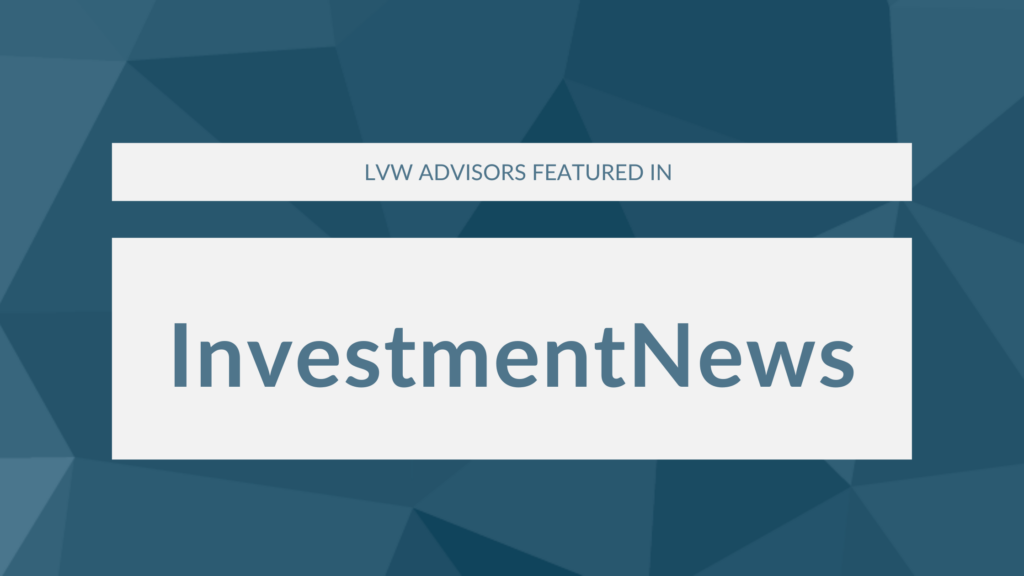Download a copy of this newsletter
Welcome to the fall edition of LVW’s The Serious Investor. We have decided to shorten this communication, providing a focused recap of the quarter. Additionally, we plan to touch base with you more frequently through alternative channels, including LVW’s LinkedIn page, LVW website postings and webinars. We hope you find this edition to be informative and constructive. Feel free to share with family and friends and send us your feedback.
Quarterly review
In the third quarter, market performance hinged on investors’ outlook for inflation and Federal Reserve policy.
Inflation initially eased slightly from very high levels, in part because of large drops in energy prices. Many observers began to anticipate that the Fed would end its tightening cycle later this year and might succeed in engineering a soft landing for the economy. This expectation helped risk assets rally in July and August, with the S&P 500 gaining 17%. Bond yields fell in July in anticipation of a possible Fed pivot and rose modestly in August.
The market environment changed dramatically in late August. Fed Chair Jerome Powell on August 26 gave a hawkish speech at Jackson Hole, noting that the Fed was committed to bringing inflation down to its 2% goal even at the cost of pain to households and businesses. A surprisingly high August inflation reading reinforced the belief that the Fed would tighten more and for longer than was priced into the market. Leading economic indicators softened, signaling a rise in the odds of recession.
Stocks and other risk assets plummeted between mid-August and September, with the S&P 500 falling more than 16%. Bond yields jumped on the prospect of higher-than-expected policy rates: The yield on the 10-year Treasury climbed to near 4% in late September, up from a low of 2.57% to begin August. All major financial assets apart from the U.S. dollar produced below-average returns the last month of the quarter.
These conditions contributed to the most challenging year for investors since 2008. Between January and September:
- U.S. equities returned -24%
- Global equities returned -25%
- The yield on the 10-year Treasury note increased 2.2 percentage points, driving prices down 16.8% this year.
- Based on index returns, a traditional U.S. 60/40 portfolio lost more than 20%.
Our investment discipline considers markets through the lens of valuation, growth and liquidity. Our analysis leads us to the following conclusions as of early October:
Valuation: Positive overall, with exceptions
Valuations vary greatly around the world. Our work suggests that international developed markets and emerging markets are priced well below average. Valuations in U.S. large-cap equity have come down since the beginning of 2022 but are not cheap on a capitalization weighted basis. However, value stocks in aggregate trade below 20-year average valuations, while growth looks overvalued on the same basis. Small-cap valuations are approaching inexpensive levels relative to their history, nearing levels we saw in 2008-2009. If earnings estimates for 2023 were to come down dramatically, valuations would be less attractive than they appear. This year we have experienced the most devastating period for bonds since at least 1926, and it is shaping up to be the worst year for bonds since reliable record-keeping began in the late 18th century. Relief may be felt when interest rates stop rising and current yields suggest a favorable risk/reward dynamic for hold-to-maturity investors.
Growth: Positive (for now)
Europe, Asia and most economies outside of the United States are suffering from a lack of growth, if not in outright recession. In the U.S., both revenue and earnings continue to grow, but we expect earnings to fall as the Fed continues tightening and margins come under greater pressure. The Fed is consistent in its messaging that growth needs to slow in order to loosen up the labor market and tamp down inflation.
Liquidity: Negative
Financial conditions have tightened considerably on the heels of the Fed moving from “Quantitative Easing to Quantitative Tightening.” Increasing fed fund rates as well as the process of unwinding its $9 trillion balance sheet has had a material impact on interest rates. Dollar liquidity as measured by M2 (money supply) peaked in March 2021 and has been declining since. It is now negative for the first time since 2015, and it has reached the danger zone where financial or economic accidents historically have been more likely to occur.
Bottom Line
The Fed is raising interest rates and removing liquidity from the financial system at a rapid rate. Economic activity is rolling over as a result of this tightening and continued strength in the U.S. dollar. We suspect that the economy will enter recession sometime in 2023. Earnings estimates will come down and the market will likely find a bottom. At some point, we will likely rebalance back toward equities, but at this point do not believe the market has fully priced in the earnings declines that usually accompany a recession. This is a “man-made” slowdown. While the Fed has been vocal in support of its current direction, we are mindful that the Fed can also reverse its action to create a “man-made” recovery.
Disclaimer: This material is provided by LVW Advisors (“LVW” or the “Firm”) for general informational and educational purposes only. Investing involves risk, including the potential loss of principal. Past performance may not be indicative of future results, and there can be no assurance that the views and opinions expressed herein will come to pass. No portion of this commentary is to be construed as a solicitation to effect a transaction in securities, or the provision of personalized tax or investment advice. Certain of the information contained in this report is derived from sources that LVW believes to be reliable; however, the Firm does not guarantee the accuracy or timeliness of such information and assumes no liability for any resulting damages. Any reference to a market index is included for illustrative purposes only, as an index is not a security in which an investment can be made. Indices are unmanaged vehicles that serve as market indicators and do not account for the deduction of management fees and/or transaction costs generally associated with investable products. To the extent that this material concerns tax matters, it is not intended or written to be used, and cannot be used, by a taxpayer for the purpose of avoiding penalties that may be imposed by law. Each taxpayer should seek independent advice from a tax professional based on his or her individual circumstances. The information in these materials may change at any time and without notice.
LVW is an SEC-registered investment advisor that maintains a principal office in the state of New York. This registration does not constitute an endorsement of the firm by the Commission, nor does it indicate that the adviser has attained a particular level of skill or ability. The Firm may transact business only in those states in which it has filed notice or qualifies for a corresponding exception from applicable notice filing requirements. Additional information about LVW is contained in the Firm’s Form ADV disclosure documents, the most recent versions of which are available on the SEC’s Investment Adviser Public Disclosure website, www.adviserinfo.sec.gov.









